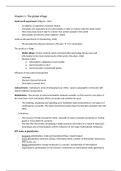Chapter 1: The global village
Small world experiment (Milgram, 1967)
- Six degrees of separation (network theory)
- Everybody was separated by six other people in order to connect with the whole world
- How many steps does it take to connect two random people in the world
- How people can become closer together, linked
Small world experiment 2.0 (Zuckerberg, 2012)
- FB calculated the distance between 2 FB users 3.57 connections
The world as a village
- Global village: a future world in which communication technology brings news and
information to the most remote parts of the world. (McLuhan, 1962)
- Situation today
o Information is ubiquitous (mass media)
o Communication is 24/7
o Communication is potentially global
Influence of own cultural perspective
- Language
- Manners (formal/informal)
- Orientation towards time
Cultural home = individual’s sense of belonging to an ethnic, racial or geographic community with
shared traditions and practices
Globalization = the process of interconnectedness between societies, so that events in one place of
the world have more and deeper effects on people and societies far away.
- The widening, deepening and speeding up of worldwide interconnectedness in all aspects of
contemporary social life. This interconnectivity breaks down the boundary between East and
West.
In business:
- The increase of trade around the world, especially by large companies producing or trading
goods in many different countries.
- The idea that the world is developing a single economy and culture as a result of improved
technology and communications and the influence of very large multinational companies.
KOF index of globalization
- Economic globalization: trade and investment flows, import/export
- Social globalization: personal contact, information flows, number of McDonalds restaurants,
IKEA stores, etc.
- Political globalization: foreign embassies in a country, membership of international
organizations, participation in UN missions, involvement in international trade agreements
,Three perspectives on globalization
1. Globalists: inevitable development, cannot be resisted or significantly influenced by human
intervention
2. Traditionalists: most economic and social activity is regional, rather than global, significant
role of nation-states
3. Transformationalists: significant shift, but there is still significant scope for national, local
and other agencies
Contributors to cultural diversity:
1. Advanced technology and transportation, and increased mobility
o Easier to travel, easier to interact
o Smaller, yet more diverse world
o Challenge: Understanding other cultures
2. Global economy and business transactions
o Global transformation: local markets as diverse as global markets
o International expansion: MNCs operating globally, and outsourcing to low-wage
countries
o Diverse workforce: migrant workers, expats
o Challenge: Understanding cultural tensions created by economic
transformations we face in intercultural communication in business context
3. Mass (im)migration and international exchange
o Immigration flow, from developing to developed countries
o Migrant workers who move to a host country temporarily
o Student exchanges
o Challenge: facilitating inter-ethnic co-existence
Necessity and benefits of intercultural communication
- Multiculturalism
o The composition of a society made up of diverse cultures
o A society’s tolerance to diversity and acceptance of equal societal participation of
diverse groups
- Building intercultural understanding
o Become aware of cultural rules by being confronted with cultural rules of others that
are different
- Promoting international business exchange
o Communicating with unfamiliar cultures does not simply mean finding a translator
o Understanding cultures and cultural differences is the key to successful business
exchange
- Facilitating cross-cultural adaptation
o The tension between immigrants and host nationals often centres on the issue of
cultural maintenance – melting pot or salad bowl?
, Chapter 3 – Communication and culture
Communication = the process by which people use shared verbal or nonverbal codes, systems, and
media to exchange information in a particular cultural context.
Effective communication
The closer the interpreted meaning (receiver) is to the intended meaning (sender), the more
effective the communication
The Linear Model (transmission model) – Shannan & Weaver
Sender has to formulate something (encode information) Send to the receiver who interpreters
the message (decode information)
- One-way communication only – no room for feedback
- Context and situation not represented
- Non-verbal communication not represented
Sender has to formulate something (encode information) Send to the receiver who interpreters
the message (decode information) Give feedback to the sender
The Interactive Model – Schramm
- Sender and receiver communicate simultaneously
- Communication is interactive
- Communication takes place in a particular context, and is influenced by that context
The Multilayer Model – Targowski & Bowman
- Contextual knowledge is included
- Verbal and non-verbal codes
- Model shows complexity of intercultural communication
- Multiple layers/factors (10)
1. Physical link
o Presence & frequency of use of communication channel/means?
2. Systems link
o Is the channel or medium appropriate for sending the message?
3. Audience link
o Does the message fit the audience?
o Size of audience, knowledge, attitude
4. Session link
o Is the message sent and received at the same time and under the same
circumstances?
o Time zones (and e.g. season differences – winter/summer)
o Appropriateness of time/moment (e.g. after work, public holidays)
5. Environmental link
o In which environment is the message produced? Do sender and receiver experience
the environment in a similar way?
6. Functions / role link







